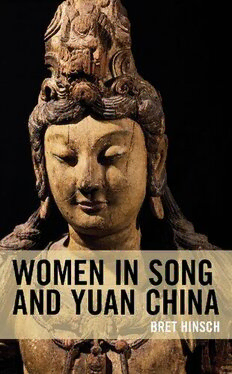
Women in Song and Yuan China PDF
Preview Women in Song and Yuan China
Women in Song and Yuan China Women in Song and Yuan China Bret Hinsch ROWMAN & LITTLEFIELD Lanham • Boulder • New York • London Published by Rowman & Littlefield An imprint of The Rowman & Littlefield Publishing Group, Inc. 4501 Forbes Boulevard, Suite 200, Lanham, Maryland 20706 www .rowman .com 6 Tinworth Street, London SE11 5AL, United Kingdom Copyright © 2021 by The Rowman & Littlefield Publishing Group, Inc. All rights reserved. No part of this book may be reproduced in any form or by any electronic or mechanical means, including information storage and retrieval systems, without written permission from the publisher, except by a reviewer who may quote passages in a review. British Library Cataloguing in Publication Information Available Library of Congress Cataloging- in- Publication Data Names: Hinsch, Bret, author. Title: Women in Song and Yuan China / Bret Hinsch. Description: Lanham : Rowman & Littlefield, [2021] | Includes bibliographical references and index. Identifiers: LCCN 2020033387 (print) | LCCN 2020033388 (ebook) | ISBN 9781538144916 (cloth) | ISBN 9781538144923 (epub) Subjects: LCSH: Women—China—History—To 1500. | Women—China—Social conditions. | Sex role—China—History—To 1500. | China—History—Song dynasty, 960–1279. | China—History—Yuan dynasty, 1260–1368. Classification: LCC HQ1767 .H58 2021 (print) | LCC HQ1767 (ebook) | DDC 305.420951—dc23 LC record available at https://lccn.loc.gov/2020033387 LC ebook record available at https://lccn.loc.gov/2020033388 The paper used in this publication meets the minimum requirements of American National Standard for Information Sciences—Permanence of Paper for Printed Library Materials, ANSI/NISO Z39.48-1992. Contents Chronology of Dynasties and Eras vii Introduction 1 1 Family 11 2 Government 37 3 Wealth 57 4 Religion 75 5 Learning 87 6 Virtue 99 7 Image 121 8 The Conquest Dynasties 131 Conclusion: The Tang–Song Transition and Women’s History 149 Glossary 155 Notes 159 Bibliography 181 Index 209 v Chronology of Dynasties and Eras Tang dynasty 618–907 Five Dynasties and Ten Kingdoms era 907–979 Liao dynasty 916–1125 Northern Song dynasty 960–1127 Jin dynasty 1115–1234 Southern Song dynasty 1127–1279 Yuan dynasty 1271–1368 Ming dynasty 1368–1644 vii Introduction Introduction Introduction Chinese women have always lived out their lives amid the currents of national affairs, subject to both abrupt upheavals and gradual shifts.1 In the course of China’s long history, several eras stand out as transformational. In antiquity, the invention of basic technologies such as agriculture, metallurgy, and writing allowed a sophisticated civilization to emerge. National unifica- tion in 221 BCE, concurrent with the establishment of the emperor system, set down a political arrangement that endured for more than two millennia. And the fall of the Han dynasty in the third century CE initiated a long inter- lude of division and chaos that only came to an end when the Sui dynasty reunited the realm in 589. This book covers the changes that resulted from the next great period of transition, when a far more prosperous and dynamic society rose up to replace the aristocratic caste system. The era following the fall of the Eastern Han dynasty is often referred to as medieval. At that time, power, wealth, and prestige became closely tied to genealogy. A person’s obligations and oppor- tunities were usually predetermined at birth. Although the uppermost elite usually lacked noble title, historians nevertheless refer to them as aristocrats because they inherited their privileged status.2 Aristocratic families intermar- ried for generations, creating an exclusive caste. Though small in number, they dominated politics, the economy, and culture. This social framework endured until the end of the Tang dynasty. As the rulers of the Tang dynasty steadily lost control of China’s periphery, the dynasty went into a long decline. Finally in 907 a warlord deposed the last Tang emperor, bringing the dynasty to a close. As the state collapsed, bandits pillaged the main cities, targeting the aristocracy in particular. The elite had congregated around the capital city of Chang’an, as many of them served in the central government. By gathering together in such a small area, they made 1
